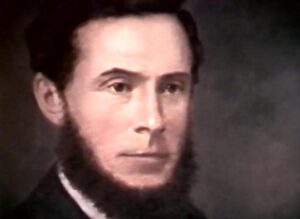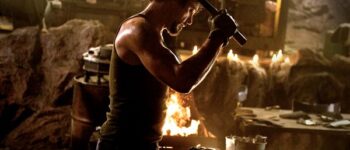1873: I Am Iron Man
November 17, 2021
By AHNZ

Henry Shacklock was an iron man from Nottinghamshire, England, who migrated to New Zealand in 1862 when he was 23. He had secure employment as a young ironmoulder in the Old World but it did not satisfy him so he came here to New Zealand, the booming land of opportunity. What happened instead must have been a sort of purgatory. Shacklock was reduced to working as a scrub-cutter on the wilds of the Otago Peninsula.
Tony Stark of Marvel Comics and film fame has a similar back-story leading up to his becoming Iron Man. Lost in the wilderness, far from modern conveniences and technology, the hero’s journey snapped the privileged Stark from privileged complacency. Shacklock, like Stark, was on a course to literally forge his own future rather than follow the well laid tracks to success that other men had set.
It took another 10 years until, in 1871/2, Shacklock was where he wanted to be as master of his own company. He was a self-starter, using his family capital to begin his own business as an ironfounder. As Stark created the Mark 1 Ironman suit, Shacklock created the mark 1 Orion coal range. Both the real life iron man and the fictional one found their revelation in serving the people. New Zealanders needed the Orion, a New Zealand product for New Zealand conditions. It became the heart of every home for the next 50 years.
Our Iron Man, like the film version, created many different variations of his iron creation to suit different specialties. The second Iron Man film explores this obsession and Stark’s journey to overcome it rather than be consumed by it. Unfortunately, Shacklock’s life didn’t achieve such an heroic character arc. At 63, retired, the company was now in the hands of his children who had become politicians. A man who has worked all his life and is ego-invested in a process now lost to him has lost his purpose. Put out to pasture, his inheritors gave Shacklock a summer house to amuse him in old age. On 17 December 1902 he hanged himself in it.
“Shacklock was not an entrepreneurial businessman, however. He stuck to what he did best..continued many of the craft-based industrial traditions of his Midlands training. The foundry was the basis of the firm, and Shacklock remained at heart an ironmaster. He was regarded as a just and fair-minded employer, who rewarded quality work and had a paternal interest in his workers.” – Te Ara
“For fifty years it was the hearth of New Zealand. On this cosy range pioneer families boiled their water, baked their bread, cooked their food. And around it they warmed their toes, dried the babies nappies and aired their views on everything from the state of the weather to the fate of the nation.” – Cumberland, Landmarks (1981)
“..I’m sure he did it because he couldn’t cope with doing nothing..they gave him a summerhouse, a bowling green, I guess he’d have been happier back working.” – Jack Shacklock, Henry’s grandson; NZ on Screen
“There’s a theory about Bendix Hallenstein and some of the other start-up industries of the age – the notion is that they became pivotal on the back of the depression that followed the end of the Vogel boom. Some of them had been bubbling along for a while; the new environment then gave a kick-start to small industries and supercharged the medium ones. The theory goes that as a result of people such as Hallenstein, Shacklock and so forth, the ‘depression’ of the 1880s was actually more a kind of re-balancing. I covered it off in my book “Old South” (now, alas, out of print, but we’ll see about that in a while…) They certainly shaped New Zealand’s retailing world of the twentieth century.”- Matthew Wright comment to History Geek (2012)
“Often it was the only warm room in the house…when people remember the coal range they also remember reading, sharing stories, taking baths, listening to the radio, playing games, dancing and singing, because all of these things happened in front of the range.” – Katie Cooper
 It’s curious that one of the great winners of the Vogel Boom, William Larnach, took his own life in the end while one of the great winners emerging from Vogel’s Long Depression, Shacklock, did the same. The Shacklock era marked a generation who self-identified with the skill set and the products of their home coal range. They never really got old or broke down and it was only the new age of electricity use that put the range out to pasture. According to Jack Shacklock he came back from WW1 to find his political uncles had neglected to keep up with the changing industry. So it was that electric stoves stole the march and Shacklock is no more.
It’s curious that one of the great winners of the Vogel Boom, William Larnach, took his own life in the end while one of the great winners emerging from Vogel’s Long Depression, Shacklock, did the same. The Shacklock era marked a generation who self-identified with the skill set and the products of their home coal range. They never really got old or broke down and it was only the new age of electricity use that put the range out to pasture. According to Jack Shacklock he came back from WW1 to find his political uncles had neglected to keep up with the changing industry. So it was that electric stoves stole the march and Shacklock is no more.
 In the c.1990s actor Ian Watkin featured in a last ditch effort to keep the Shacklock brand alive. A younger man played Shacklock who sweated away in a montage forging a single mark 1 Orion and then offered it to the prospective buyer, Wakin. “Well done Shacklock!” says Watkin in a Colonial brogue, “I’ll take six!”
In the c.1990s actor Ian Watkin featured in a last ditch effort to keep the Shacklock brand alive. A younger man played Shacklock who sweated away in a montage forging a single mark 1 Orion and then offered it to the prospective buyer, Wakin. “Well done Shacklock!” says Watkin in a Colonial brogue, “I’ll take six!”
Katie Cooper noted that there was a generational attachment to the Shacklock. A house wife’s identity, routines, and skill set was invested in her ability to use the range and she could not transition to electric without adapting or giving up parts of who she was. For the most part they didn’t. The range generation died out, the electric generation replaced them. The kitchen was to the New Zealand family what the command bridge is to an ocean-going ship, the range its engine. In giving up the range because it was technologically obsolete we were also giving up an array of family and community roles and interconnections that were not obsolete but were now deprived of their superstructure. The locus of the family in the electric age became not the hearth but the television set. Or, worse, the family doesn’t even share focus on the same external locus together but each is away in its own world on individual semi-cybernetic devices such as smart phones. Hard to respect a house mistress as if she were a kitchen chief engineer and a star ship helmswoman, as once she was, when her duty involves calling up the fast-food delivery guy to the door with dinner. Gone too the family dining table; The new New Zealanders eat off their laps sitting on the couch.
Houses, too, were designed to have the coal range for a heart that has now been amputated and replaced with an electric ‘pace maker’. No wonder our older homes are cold and damp. They were designed for a coal range that belted out radiant heat and dispelled humidity. Now we wonder why it’s so cold and our hot water and home heating bills are so high! How did our ancestors live in houses like this? And how did they achieve so much and survive so much with families and a culture like ours? The answer is that they didn’t live like this at all. They had a Shacklock.
—
Ref. Old Money – Hudson, Sargood, Hallenstein, Hannah, Shacklock, Messenger Films (1999); NZ on Screen
Ref. Hearth and home: Reconstructing the rural kitchen, c1840–1940, Dr Katie Cooper talk (2017)
One thought on "1873: I Am Iron Man"
Leave a Reply
 Like Comment Share
Like Comment Share






When I wrote this I initially guessed the buyer asked Shacklock for “twenty.” That was based on a 30yo memory. Now I have the clip I’ve changed it to “I’ll take six!”